The Border Wall's Wildlife Impacts
Air Date: Week of February 15, 2019
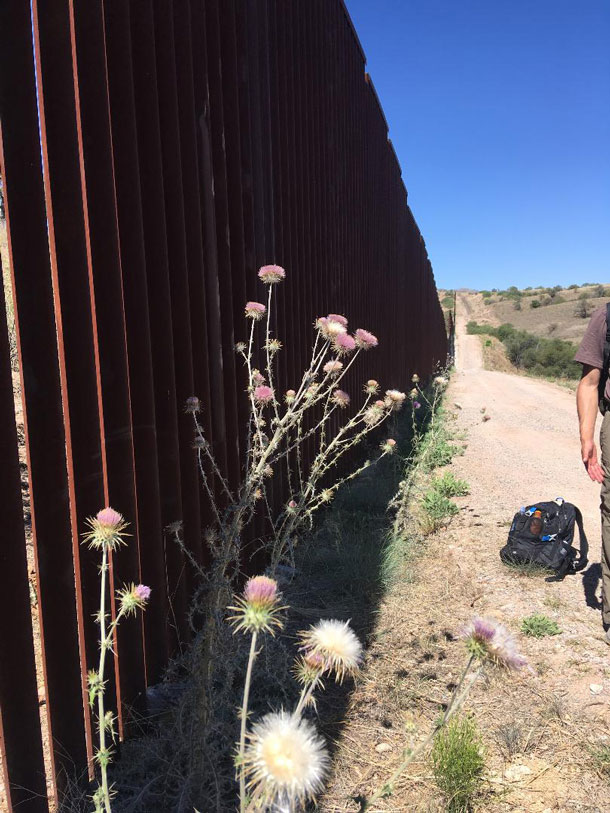
The border wall between the United States and Mexico causes various forms of damage to species native to the surrounding areas. (Photo: Courtesy of Sergio Avila)
President Trump has declared a state of emergency to secure funding for a wall along the US border with Mexico. If built, the wall would disturb critical habitats and block migration routes for animals already stressed by climate change, and could possibly lead to extinction for some rare and endangered species. Biologist and Outdoors Coordinator for the Sierra Club Sergio Avila talks with Host Bobby Bascomb about the impacts of a wall on some rare species including jaguars and pygmy owls.
Transcript
BASCOMB: It’s Living on Earth, I’m Bobby Bascomb.
[BIRD SOUNDS]
The dawn chorus at the National Butterfly Center near the Rio Grande in Texas welcomes visitors each morning.
[BIRD SOUNDS]
The private nature reserve is home to more than 200 species of butterflies and endangered species, including ocelots and jaguarundis.
The Butterfly Center is just one example of the many critical habitats in the path of the proposed border wall. A Federal Appeals court in California ruled that the Trump administration is within its rights to disregard dozens of environmental laws to fast track the wall. And the Supreme Court has declined to hear a challenge from environmental groups. The wall would be nearly a thousand miles long and pass through critical wildlife habitat. Sergio Avila is a biologist and Outdoors Coordinator for the Sierra Club in the Southwest and joins me now. Sergio, welcome to Living on Earth!
AVILA: Thank you, Bobby. Glad to be here.
BASCOMB: Now, you've spent quite a lot of time in the border area. I know it's not a homogenous landscape, of course, but if you could please choose one of your favorite spots there and describe it for someone who's never been.
AVILA: Ah, yes. This is a great, beautiful region with rivers and valleys and mountains and deserts. For example, the Sonoran Desert is one of my favorite ones. The Sonoran Desert is defined by the saguaros, those iconic cacti that have big arms. And you can see a forest of saguaros when you stand on a hill. And you can imagine a long valley with mountains on the sides and these saguaros standing out there. Some of these plants are ancient. They were there when the Spanish first got to North America. They have seen the changes in the seasons, the changes in the people, the development in the desert. These saguaros have provided the life not only for birds but also for local communities whose culture is very closely associated to saguaros. We also have other types of cacti with beautiful red and pink and orange and yellow flowers that are super, super conspicuous during the spring. Right now, after the winter rains, the Sonoran Desert has a carpet of poppies. So you can go to some hills and just see orange all over and it's buzzing with bees and hummingbirds. So this is one of my favorite places along the border, the Sonoran Desert.
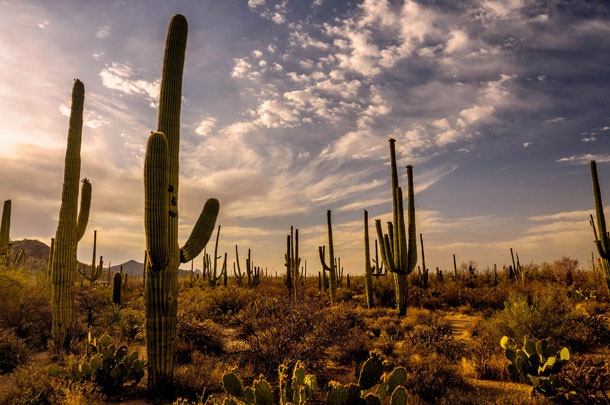
Saguaro Cacti are one of the defining species of the Sonoran Desert. (Photo: Ade Russell, Flickr CC BY-NC-ND 2.0)
BASCOMB: A wall both takes up space, which is an important habitat for animals, but it also blocks the migration path for many migrating species. Is that right?
AVILA: That is right. Blocking the migration prevents species from doing their normal life cycle. It's very clear that nature has no borders. All of these plants and animals and places that I have described exist in this region regardless of the borders, regardless of the political boundaries and straight lines that humans like to set. So all of these animals are blocked in their day to day activities or in their wide-ranging, looking for new territories. Specifically for jaguars. Jaguars are the third largest species of cat in the world, right after Siberian tigers and African lions. So, that is a big spotted orange and black cat that lives not only in the jungles of the Amazon but also in the Borderlands of Arizona and New Mexico. And we have records of these cats living up in the Grand Canyon in the beginning of the 1900s. So this is not just like an individual occurrence, this is part of their territory. This is part of their distribution range. And I have to say that it doesn't matter if these jaguars are north or south of the border. They are still blocked. They cannot reach food, they cannot reach water and they cannot reach mates for the future generations.
BASCOMB: Wow. It's pretty amazing, one animal that can live both in the Amazon rainforest and the Grand Canyon, which is very dry.
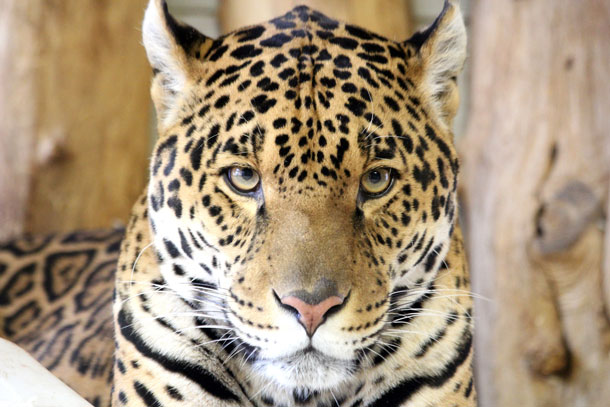
One of the species impacted by border walls is the jaguar, whose native range is anywhere between the Amazon rainforest and the Grand Canyon. (Photo: a_wilson, Flickr CC BY-NC-ND 2.0)
AVILA: And, in fact, one of the impacts that we have to address in regards to border walls and all this infrastructure is that also some of these animals are trying to move in a way to adapt to climate change. So some of these animals might be moving from warmer areas to cooler areas. Either from going from the south to the north, or from lower elevation to higher elevation areas. And so it's very important that we acknowledge that the border barriers are compounding the impacts of climate change by not allowing animals to move freely and to adapt and reach water or reach food or reach cooler places where they can survive.
BASCOMB: I understand even some bird species could have a hard time with the wall. Can you tell me please about the cactus pygmy owl?
AVILA: Absolutely! It's really good to address birds and species that many people think will not be impacted but, one example in the desert is the roadrunner, which many people know from the cartoons. I have to say the real one is a little smaller, it flies but it doesn't fly that high. So we have seen roadrunners just going back and forth in the border wall because they can't cross it. And that's very sad to see. And the same thing with the cactus ferruginous pygmy owl. Pygmy owls are tiny little owls, about five to six inches tall, that have very short flights. And they need to swoop, so they use a perch, like let's say they're sticking out their head out of the cavity in a saguaro, they need to swoop down and fly very low until they reach another place where they can perch or stand. And so if that area where they fly is blocked by a border wall the owls won't be able to fly over it. And that's not only pygmy owls but also elf owls and possibly even great horned owls.
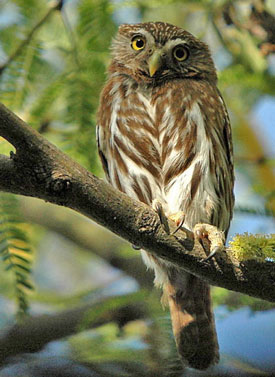
The Cactus Ferruginous Pygmy Owl is a low-flying owl that has a flight pattern that cannot clear barriers like border walls. (Photo: Wikimedia Commons Public Domain)
BASCOMB: Now some fish, as well, won't have full access to the rivers they need. Can you tell me about that, please? How fish might be impacted?
AVILA: Yes, I can say about a specific case in the San Bernardino National Wildlife Refuge, where this very small area of public lands has been protected to protect the last numbers of a couple of species of desert fish. This is what we call an endemic species. It's a species that only lives in one place. And, by creating a National Wildlife Refuge the Fish and Wildlife Service is protecting the water and the water quality and the habitat that those fish enjoy in that area. What has happened now with the border and heightened law enforcement is that there's a lot of erosion, they have deviated a little bit of the creek where these fish live by blocking water. The Department of Homeland Security has created flooding that has contaminated the habitat of these fish. They also contaminated the habitat by pouring concrete inside of the creek where these fish live. And it is crazy, not only for the life of these fish but imagine for the efforts that government and non-government agencies have put in a region that is so rich biologically. So yes, it is damageful in the habitat for the fish, but it's also a lot of damage in the local work and in years of outreach and education that a lot of these public officials have conducted down here.
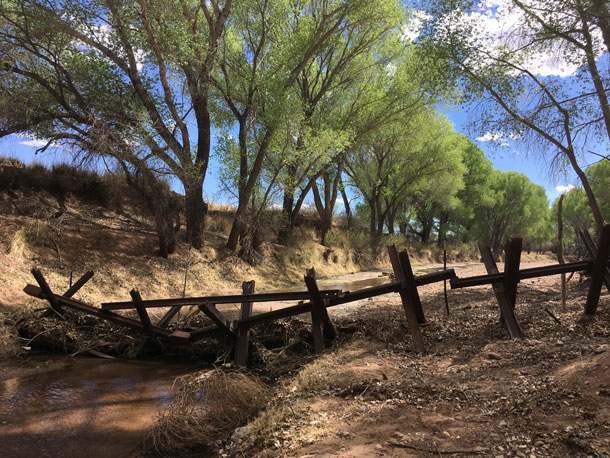
Even waterways are being blocked by border barriers, affecting native aquatic species. (Photo: Courtesy of Sergio Avila)
BASCOMB: Of the many many species that are potentially impacted by a wall, which one concerns you most if you can narrow it down?
AVILA: As a biologist, it's very difficult to disconnect one species from the rest. Because it would be very unfair for me; I'm a jaguar biologist so I'm concerned about jaguars, but if there's no deer, the Jaguars won't have anything to eat. I am concerned about the whole environmental impact in nature; everything's connected, so if we take one of the small pieces in the puzzle, all of the puzzle suffers. It's a big network. But it hurts me for bighorn sheep in the mountains of California. It hurts me for pronghorn antelope in the deserts of Arizona. It hurts to know that there is an ancient herd of bison in the Chihuahuan Desert that goes back and forth in New Mexico and Chihuahua and they are now blocked. Bison play such an important role not only in the ecosystem but in the cultures of people who have lived in these places for so long. It hurts me for the butterflies at the National Butterfly Center who are traveling from Canada to Mexico and don't find this rest area anymore. And it hurts me for all the human populations that enjoy these public lands, that enjoy national parks, that learn about their connection to nature. It hurts me for all the lost opportunities that are happening because of this.
BASCOMB: How likely is it, do you think, that some endangered species might actually go extinct as a result of a proposed border wall?
AVILA: I think it's likely. I think it's likely, and I think it's very sad because we're seeing it with our own eyes. And the solution is in our hands and yet, humans are not stepping up to do enough about that.
BASCOMB: For somebody listening to this, myself included, that's just feeling terribly depressed right now. I mean, these are iconic species, they're rare, they're endemic, you know, this wall is potentially so destructive. I mean, can you leave us on a positive note at all? Is there anything to be done for, you know, somebody that's listening to this and cares about this issue?
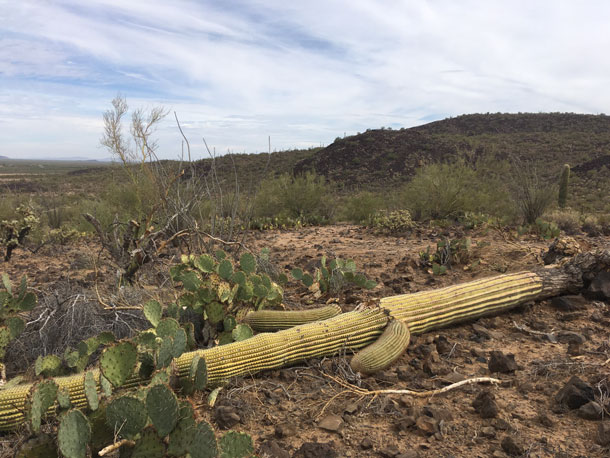
Damage due to the construction of a border wall has great impacts on species like the saguaro cactus, which is home to many other native species in their ecosystem. (Photo: Courtesy of Sergio Avila)
AVILA: Absolutely! In spite of all these challenges, political challenges, and social challenges, people need to know the Mexican gray wolves, that jaguars, that ocelots exist out there. That they are prevailing in spite of all this infrastructure. That animals are adapting to climate change, that water is still running in those rivers. And, so, with all those images, that saguaros are still standing in the summer and desert; if we keep those images alive and we know that those species are there, let's grab that hope and that energy to share our voice and speak on behalf of them.
BASCOMB: Sergio Avila is a biologist and outdoor coordinator with Sierra Club. Thank you so much for taking this time with me today.
AVILA: Thank you so much.
Links
Living on Earth wants to hear from you!
Living on Earth
62 Calef Highway, Suite 212
Lee, NH 03861
Telephone: 617-287-4121
E-mail: comments@loe.org
Newsletter [Click here]
Donate to Living on Earth!
Living on Earth is an independent media program and relies entirely on contributions from listeners and institutions supporting public service. Please donate now to preserve an independent environmental voice.
NewsletterLiving on Earth offers a weekly delivery of the show's rundown to your mailbox. Sign up for our newsletter today!
 Sailors For The Sea: Be the change you want to sea.
Sailors For The Sea: Be the change you want to sea.
 The Grantham Foundation for the Protection of the Environment: Committed to protecting and improving the health of the global environment.
The Grantham Foundation for the Protection of the Environment: Committed to protecting and improving the health of the global environment.
 Contribute to Living on Earth and receive, as our gift to you, an archival print of one of Mark Seth Lender's extraordinary wildlife photographs. Follow the link to see Mark's current collection of photographs.
Contribute to Living on Earth and receive, as our gift to you, an archival print of one of Mark Seth Lender's extraordinary wildlife photographs. Follow the link to see Mark's current collection of photographs.
 Buy a signed copy of Mark Seth Lender's book Smeagull the Seagull & support Living on Earth
Buy a signed copy of Mark Seth Lender's book Smeagull the Seagull & support Living on Earth

